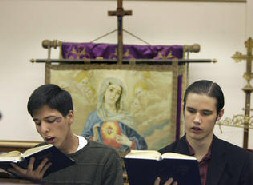

|
|
| Musical Musings: Liturgy |
The New Youth MassThis article appeared in the Spring 2008 edition of Sacred Music journal, published by the Church Music Association of America. It is reprinted with the kind permission of Jeffrey Tucker, Managing Editor
[A few years ago] our schola was invited to participate in an interesting experiment. Several priests in Montgomery, Alabama, were ready to forge ahead in a new liturgical direction. They hoped to provide a demonstration project for the parish that would be compelling enough for parishioners themselves to push for change from below. This hope stemmed from what is essentially a pastoral concern. A Tridentine [extraordinary form] option was not viable in this case. It would be attended by only a handful, and the rest of the mainstream parish Masses would be left unchanged. They couldn't risk a failed experiment that might have doomed the prospects for long-term reform. Here is what these priests decided to do. They considered the Sunday Mass schedule and the possibility of using one of the regularly-scheduled Masses as the experiment. They settled on the one they considered to be most open to new things: the youth Mass at 5pm on Sunday evening. The next step was for the priests to invite the Saint Cecilia Schola from Auburn, 45 miles north of Montgomery. We were charged with putting together a music program, not as a performance group but as teachers and helpers. Our goal was to construct a program that could be self-sustaining after we left: a musical wire frame. The priests wanted no musical instruments, and singing without them is our specialization. The idea here is to reduce to the fundamentals and let the primary liturgical instrument, the human voice, carry the entire liturgy. Our first step, in view of the Roman Rite ideal, was to reduce the number of hymns to its bare minimum. Instead of a processional hymn, we used a variation of the psalm-tone propers found in the Anglican Use Gradual. We changed some of the words so that they would accord with modern Catholic usage ("Holy Ghost" to "Holy Spirit"). We did the same with the sung offertory proper. (There is no official translation of the sung propers of the Roman Gradual, so this was not an issue.) The communion chant from the Roman Gradual is what we chose as the teaching tool for the parish schola. We sang the full chant and the psalms each week. In addition, we taught them several chant hymns suitable for the season. In each case, singers were asked to read the neumes and four-lined staffs, not modern notes. This way, they could quickly overcome the intimidation factor. For the recessional hymn, we used no accompaniment. We also taught and sang simple motets such as "Lord for Thy Tender Mercy's Sake" by Richard Farrant and Laudate nomen Domini by Christopher Tye. The Gospel was sung. The Canon was sung. The Our Father was sung. The Ordinary setting we used began with Kyrie XII, which was easily learned by the congregation. The remaining Ordinary parts, Mass XVIII, were not our favorites simply because they are overused. The idea, however, is that they are somewhat familiar to people, and because there was so much else new, these settings would keep the liturgy grounded in what people felt comfortable with. There was plenty of incense on hand, and liturgical torches were borrowed from a parish in town that had them leftover from the old days. The Mass was said mostly in English. Most dramatically, the Mass was said ad orientem. On the first Sunday, the reason was explained in detail. Mass is shaped around the idea of a people of God in procession toward the East, as led by a priest in persona Christi. The homilist explained further that he finds looking at the people from the altar to be a distraction for him, and he suspects that his own face and the personality it reveals is a distraction for the people, who should be praying. Though new to the congregation, this aspect of the liturgy turned out to be completely non-controversial in the end. Indeed, each successive week was more crowded than the last. The final liturgy was the most packed of all the Masses, and the youth were particularly engaged. In the entire season of these beautiful Masses, there was not one word of complaint, and the priests received unrelenting praise. We were particularly struck by how beneficial it was for them to have tutoring on three successive weeks (the fourth Mass was done entirely by the parish schola). As valuable as weekend workshops are, the experience of preparing Mass over several weeks is much more so. One final sociological note that we found fascinating: At the first rehearsal, a young man who looked to be about 19-years old walked up to sing. He held a blue book in his hand (the Graduale Romanum for the ordinary form) and had a look of great confidence and anticipation on his face. We welcomed him and embraced him. In fact, we had already developed a name for this archetype because we've seen them coming to so many workshops: "chant jock." The term well describes this new generation of young men who see sacred music as a venue through which to serve the faith. |
 People deserve better liturgy.
The Church's public prayer needs to be heard and sung without the intervention of pop styles and personality displays.
However, a change imposed from above, without sufficient preparation, could provoke a backlash.
People deserve better liturgy.
The Church's public prayer needs to be heard and sung without the intervention of pop styles and personality displays.
However, a change imposed from above, without sufficient preparation, could provoke a backlash.